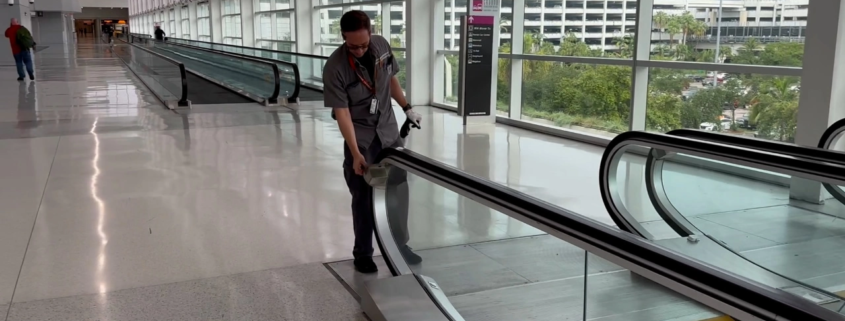An essential system of daily transportation, the moving walkway escorts millions of passengers to their destinations every year. As a functional, efficient and expedient way for individuals to manage the often overwhelming landscapes of major airports – as well as other pedestrian-congested hubs throughout the world – these efficient people movers provide their users with the reliable and safe passage they demand and deserve.
But what is involved in keeping these critical systems running safely and efficiently? And how best to ensure moving walks are maintained with the highest standards?
What Are Moving Walkways?
Moving walkways are passenger-carrying devices on which individuals stand or walk: the surface of which remains parallel to its direction of motion in an uninterrupted manner. These systems are specifically designed for horizontal transportation over short to medium distances, making them ideal for airports, transit terminals, or other high-traffic facilities.
Moving walkways have a rather lengthy history, first debuting most notably, at special demonstration exhibitions of the Chicago and Paris Expositions in 1893 and 1900. A testament to their longevity and enduring value, fast forward well over a century, and today, they are commonly found in supermarkets and shopping malls, airports and train stations all over the world.
Developed originally as a way to simply reduce heavy foot traffic, moving walkways have expanded their reach into additional areas of benefit:
Increased Mobility Access: According to the U.S. Department of Transportation, approximately 27 million people with disabilities traveled by air in 2019.¹ With these increasing and important accessibility considerations, moving walkways provide much needed assistance for individuals with mobility barriers, including: those with disabilities, the elderly, travelers with heavy luggage, or anyone who may have difficulty walking long distances. Ultimately, these systems allow for more inclusive and user-friendly access for all passengers.
Improved Passenger Experience: Moving walkways facilitate orderly travel. Pedestrians are afforded the chance to move with consistency and ease without the inherent challenges of navigating a completely open landscape: i.e., travelers walking at different speeds, or in congested areas. The result is a smoother, more predictable flow through busy terminals.
Technical Specifications: Moving Walks Built for Performance
Modern moving walkways are designed to take into account the unique environment and needs of their particular use. Below are two leading IUEC manufacturers, Otis and Schindler, and the associated specifications as a point of reference for their respective systems:
Otis Elevator Company²
- Maximum length: 262 feet
- Inclination: 0 to 3 degrees (10 and 12 degrees available on special request)
- Pallet widths (where people stand): 32 inches and 40 inches
- Speed: 100 feet per minute (higher speeds available on special request)
- Maximum length: 328 feet
- Angle of inclination: 0 to 3 degrees
- Balustrade height: 36 inches to 39 ⅜ inches
- Width(s): 40 inches, 48 inches, and 56 inches
Kone and Mitsubishi are also suppliers of moving walkways with their own specifications. The bottom line: these systems are engineered to meet the facility requirements and passenger capacity needs.
The Importance of Professional Maintenance
It will come as no surprise that moving walkways require specialized maintenance. The safety and reliability of these transportation devices depends on the expertise of the professionals who maintain them – it’s that very expertise that ultimately influences and impacts both system performance as well as passenger safety.
IUEC Training on Moving Walkway Systems
The National Elevator Industry Educational Program (NEIEP) provides specialized training to IUEC elevator constructors through course 830. This specific course, which is part of the required curriculum for all IUEC apprentices, covers moving walkway systems in detail. It is also available to IUEC mechanics.
IUEC members are trained by NEIEP to install, maintain, and repair these complex systems. This specialized education covers:
- System-specific maintenance protocols for different moving walkway technologies
- Advanced safety procedures specific to horizontal transportation systems
- Regulatory compliance requirements and inspection protocols
- Emergency response procedures for passenger safety situations
Maintenance Control Program (MCP) Compliance
Moving walkway maintenance should always be performed in accordance with a Maintenance Control Program (MCP), following ASME code requirements in your jurisdiction, and as enforced by your local Authority Having Jurisdiction (AHJ). These latter regulatory requirements ensure passenger safety and system reliability.
IUEC elevator constructors understand these complex regulatory requirements – they maintain the compliance standards necessary to keep your systems operating reliably and safely.
The IUEC Elevator Constructor Advantage
While there are numerous advantages to having moving walkway systems maintained by IUEC elevator constructors, let’s take a look at four specifically:
Comprehensive Training
As previously noted, specialization is critical when engaging with these passenger-carrying devices. To that end, IUEC elevator constructors’ extensive training through NEIEP’s Course 830 ensures they have a mastery of the following:
- Specific moving walkway technologies and components
- Maintenance requirements
- Advanced troubleshooting techniques
- Regulatory compliance processes
Uncompromising Safety Standards
Safety isn’t negotiable. And with the countless number of passengers using these systems daily, it must be at the forefront of concern and consideration. For IUEC elevator constructors, safety protocols – developed and maintained through decades of industry experience – are the very backbone of how they operate. These include, but are not limited to:
- Rigorous safety inspection procedures
- Hazard identification and mitigation
- Emergency response protocols
- Conformance to all applicable safety codes and regulations
Continuing Education
The ever-changing landscape of technology demands an equally up-to-date workforce. As new technologies continue to develop, those that apply to moving walkways must continue to evolve alongside them. To that end, IUEC elevator constructors participate in continuing education programs that keep them current with:
- Emerging technologies and corresponding maintenance techniques
- Updated safety codes and regulations
- Advanced diagnostic and repair procedures
- Industry-best practices and innovations
Business Case for Professional Care
Above we highlighted several reasons why choosing IUEC elevator constructors for maintenance and repair is the smart choice. For airport managers and facility operators alike, all of these add up to directly impacting three foundational aspects of business: operations, financials, and safety.
Operational Reliability
- Reduced downtime: Expert maintenance helps prevent system failures, including most critically during peak periods of travel
- Predictable performance: Consistent scheduling of professional maintenance reduces and can eliminate unexpected disruptions
- Extended life: These systems are substantial investments: proper maintenance protects and prolongs their lifespan
Financial Impact
- Reduced long-term costs: Preventive maintenance eliminates expensive emergency repairs
- Energy efficiency: Well-maintained systems operate more consistently and efficiently, reducing overall operational costs
- Liability protection: Professional maintenance and its associated documentation protects against potential legal ramifications
Safety & Regulatory Compliance
- Code adherence: Professional maintenance ensures compliance with ASME codes and local AHJ requirements
- Inspection readiness: Proper documentation and maintenance records support regulatory inspections
- Risk management: Professional expertise minimizes safety-related incidents and associated liability
Moving Walkway Industry Growth and Challenges
Driven by new technology, rising urbanization and associated infrastructure development – by way of both private and government agencies – growth is on the horizon for this industry. In 2024 alone, the global market was estimated at $4.2 billion; it is predicted to grow at ~5% annually to reach $6.8 billion by 2034.⁴ This trajectory clearly reflects the recognition of moving walkways as essential infrastructure: whether in airports, transit systems, or other types of commercial facilities worldwide.
Growing pains are sure to follow, however, as this aging industry isn’t without its fair share of challenges. Several evolving realities will require continued professional knowledge and intervention:
Aging Infrastructure: Many systems installed in the 1990s and 2000s require creative maintenance strategies to extend operational life while adhering to safety standards.
Increased Volume: Growing air travel and general facility usage require systems that can manage higher capacity loads than originally intended, ultimately necessitating expert maintenance to ensure continued safe operation.
Enhanced Safety Requirements: Evolving safety codes and accessibility standards require ongoing professional development to ensure compliance.
Making the Right Choice for Your Facility
Moving walkways constitute vital transportation infrastructure, connecting travelers to their destinations. Whether you’re managing an airport, commercial facility, or some other transit complex, professional maintenance and service is a must – it directly impacts passenger safety, system reliability, financial investments, and ultimately your facility’s reputation.
As we’ve outlined above, when evaluating conveyance system maintenance providers, it’s important to prioritize:
- Specialized NEIEP training in moving walkway technology
- Proven safety protocols and comprehensive, accompanying documentation
- MCP compliance expertise and regulatory knowledge
- 24/7 emergency response capabilities for critical transportation facilities
- Ongoing professional development to stay current with evolving technologies
For the millions of travelers globally who depend on transportation systems, moving walkways and the specialized IUEC elevator constructors that service them ensure that at least a part of their journey continues smoothly, unencumbered, safe, and stress free.
References:
1U.S. Government Accountability Office. “Passengers with Disabilities: Barriers to Accessible Air Travel Remain.” Available at: https://www.gao.gov/products/gao-23-106358
2Otis. “Escalators and Moving Walkways.” https://www.otis.com/en/us/products-services/products/escalators-and-moving-walks
3Schindler. “Horizontal Walk for Moving Transit.” https://www.schindler.com/en/escalators-moving-walks/moving-walk/schindler-9500-horizontal.html
4Global Market Insights. “Moving Walkways Market Size & Share, Statistics Report-2032.” Available at: https://www.gminsights.com/industry-analysis/moving-walkways-market

